Softball players with curly hair often struggle to control their unruly strands during games. The other players concentrate on their performance while you battle frizz and flyaways under the scorching heat.
My experience helping athletes become skilled at managing their curly hair for softball has taught me that standard hairstyles rarely work well enough. These 15 game-changing styles will stay in place through your entire game. The collection includes protective box braids and modified Dutch braids that complement your natural texture.
These styles work perfectly for all curl types, from tight coils to loose waves. Your hair remains secure and easy to manage through nine innings. You won’t need to fix your hair mid-game or adjust your helmet repeatedly. These practical, protective styles let you concentrate on what counts – playing softball at your best.
Dutch Braids with Low Buns for 3A-3C Curls
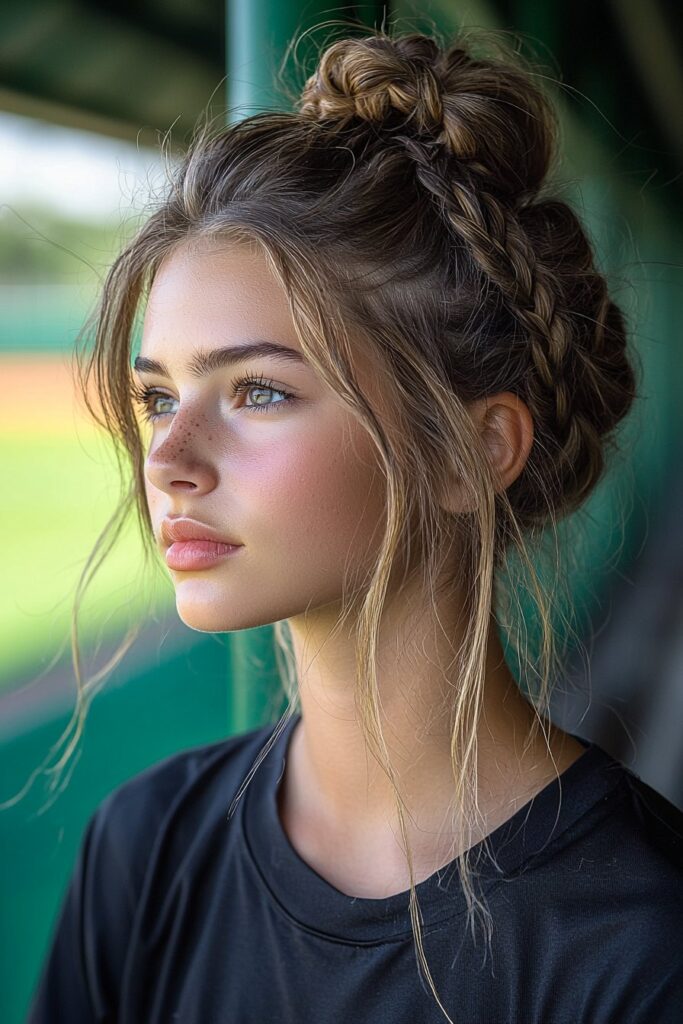
Dutch braids help you manage 3A-3C curls for athletes who need their hair secure during diving catches and base slides. These inverted beauties keep curls in place while looking stylish, unlike regular braids.
Why This Style Works for Curly Hair
Dutch braids are a great way to get both security and protection for 3A-3C curl patterns. The inverted technique creates a raised braid that sits close to the scalp as sections cross under instead of over. This works great especially when you have curly textures that frizz or expand with sweat and movement.
This style’s versatility makes it special. Dutch braids’ “inside-out” nature works with your curl pattern instead of fighting it. This prevents frizz and flyaways that many curly-haired athletes struggle with. Low buns contain all those ends that usually escape during intense activity.
Step-by-Step Tutorial
- Start with slightly damp hair (this provides better grip for curly textures)
- Apply a small amount of mousse throughout for hold
- Part hair down the middle from forehead to nape
- Begin the Dutch braid by taking three small sections at the hairline
- Cross the side sections under the middle section (this creates the raised effect)
- Add hair to each section before crossing under
- Continue braiding to the nape of your neck
- Secure with an elastic
- Repeat on the other side
- Twist each braid into a low bun at the nape
- Secure buns with bobby pins and hairspray
The main difference from French braids shows in how sections cross under instead of over to create that distinctive raised look.
Products That Keep It in Place
The right products make the difference between a style lasting three innings versus a full doubleheader for curly athletes. Eco Styling Gel gives excellent hold for curly textures without crunchiness. Lightweight mousse works better than heavy gels for finer curls.
Strong-hold hairspray tames those stubborn flyaways that try to escape. My clients love edge control products made for curly hair to keep baby hairs in place.
How I Styled This for a Professional Athlete
A pitcher with 3B curls came to me last season because her hair kept escaping her ponytail. She needed a solution before a big tournament, so I suggested Dutch braids with low buns. She wasn’t sure at first but decided to give it a try.
I worked with her damp hair, added extensions that matched her team colors, and created tight Dutch braids flowing into secure low buns. The style stayed perfect through seven games in humid weather and fit under her visor without causing discomfort.
The best part? She could focus on pitching without fixing her hair constantly. The style looked amazing in team photos after the game – she just had to remove her visor.
Protective Box Braids for 4A-4C Curls
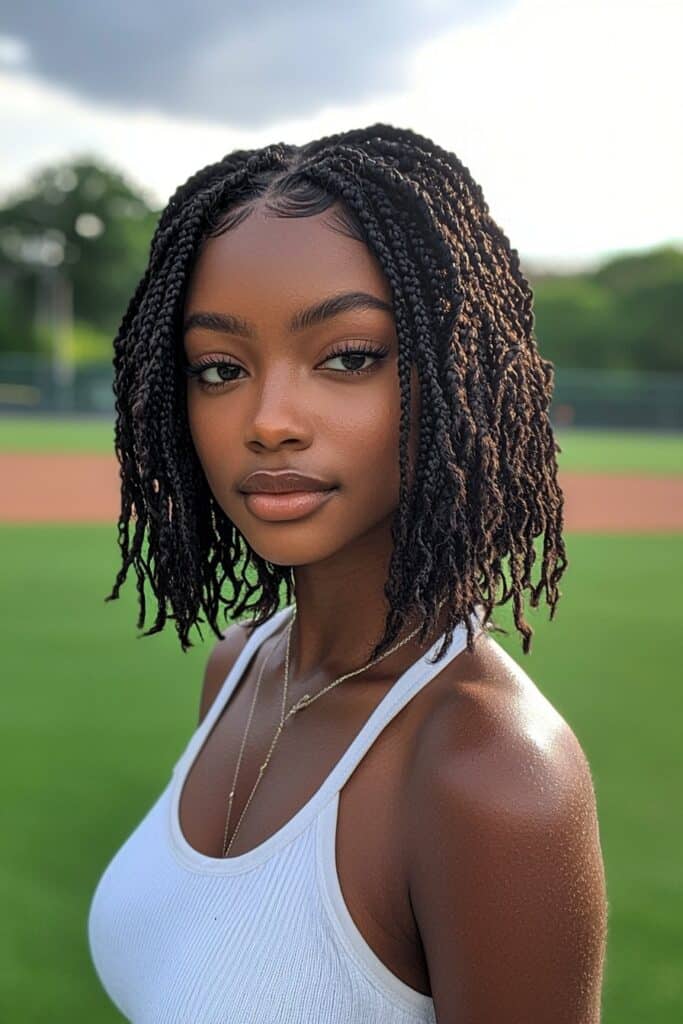
Box braids have become the perfect protective style solution for my softball players with tight 4A-4C curl patterns. These braids protect delicate curls from damage and stay versatile through multiple games and practices.
Pre-Braiding Moisture Prep
Success with box braids for athletic clients starts with the right preparation. I always start with a clarifying shampoo that removes product buildup and cleans the scalp. A protein treatment followed by a moisturizing deep conditioner gives your natural hair the strength to handle the braids’ weight.
Your hair needs good detangling. I use a wide-tooth comb with lots of conditioner to prevent breakage. My clients know this truth: “The better moisturized your hair is before braiding, the better hydrated it will stay throughout the entire protective style.”
Creating Long-Lasting Box Braids
Box braids for athletes need special attention to detail. The parts should stay under half an inch – this helps spread tension evenly across the scalp. The edges shouldn’t be too tight, and the hairline needs some breathing room.
Medium-sized braids work best for softball players compared to jumbo styles. Players can wear their helmets comfortably with these lighter braids that still handle sweat and movement well. Human hair extensions hold up better than synthetic ones during intense physical activity.
Game Day Styling Options
Game days call for these great box braid styles:
- High ponytails with a secure, reinforced base
- Three jumbo braids wrapped into a protective crown
- Banded ponytails that contain the bulk while distributing weight
Low buns at the nape work great with helmets. My players love when I wrap colorful team-matching scrunchies around braid sections – it shows team spirit and keeps everything secure.
Post-Game Maintenance
Players need good maintenance after intense games. A diluted shampoo mixture applied with a small applicator bottle works best, mainly on the scalp. Natural oil moisturizing spray keeps braids hydrated without buildup.
A satin scarf at bedtime stops friction that causes frizz and loose braids. Box braids should be redone every 6-8 weeks – active players might need it sooner. Waiting longer makes removal tough and leads to tangling.
Pineapple Updo with Secure Edges
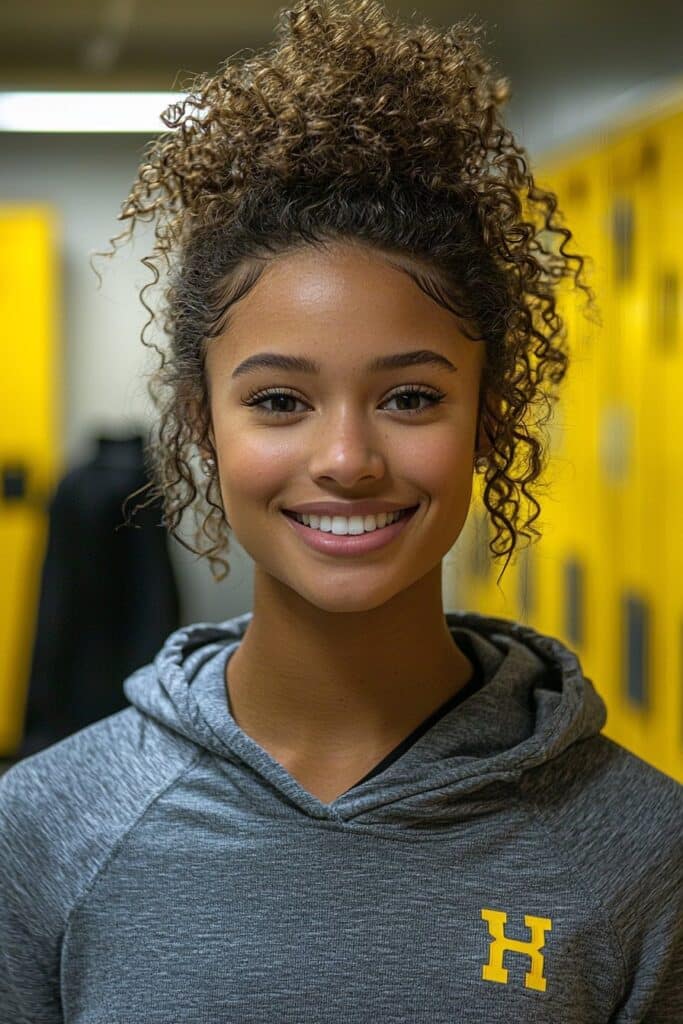
The pineapple updo has been a game-changer for my curly-haired softball clients. This style strikes the perfect balance between security and simplicity. Athletes can keep their hair under control through multiple innings without adjusting it constantly.
The Perfect 5-Minute Style
Simplicity makes the pineapple updo so appealing. My process starts with a light spritz of water to rejuvenate the curls. The next step involves flipping the head upside down and gathering all curls into a high ponytail at the crown. A loose yet secure ponytail prevents tension headaches while staying firmly in place during active play.
Players should follow these game-day preparation steps:
- Start with slightly moisturized curls (too dry leads to frizz; too wet causes mid-game shrinkage)
- Place the ponytail at the very top of the head
- Use an adjustable hair tie that won’t snap under pressure
- Gently tug at the base to release any tension
Stretched-out wash-and-go curls get new life from this style without starting over.
Edge Control Products for Athletes
My softball clients helped me find edge control products that stand up to sweat and movement. Creme of Nature Argan Oil Perfect Edges works best for athletes. It provides excellent hold without leaving residue during intense activity. The argan oil in this product keeps delicate edges moisturized throughout play.
Gorilla Snot Gel gives remarkable staying power for players in high-movement positions. Applying too much can cause flaking. Thin layers of edge control work better than one thick application.
Helmet Compatibility Tips
Softball helmets pair perfectly with the pineapple updo. Hair bulk sits high on the head, letting the helmet fit correctly around the sides and back. A few adjustments help maximize comfort:
The pineapple should sit directly on top rather than toward the back. A satin scarf wrapped around the pineapple’s base creates protection against friction between hair and helmet. This prevents breakage and frizz effectively.
Shorter curly styles need a looser pineapple position toward the front. This keeps shorter strands from straining while tucking them safely away from equipment.
Twisted Crown Braid for Loose Curls
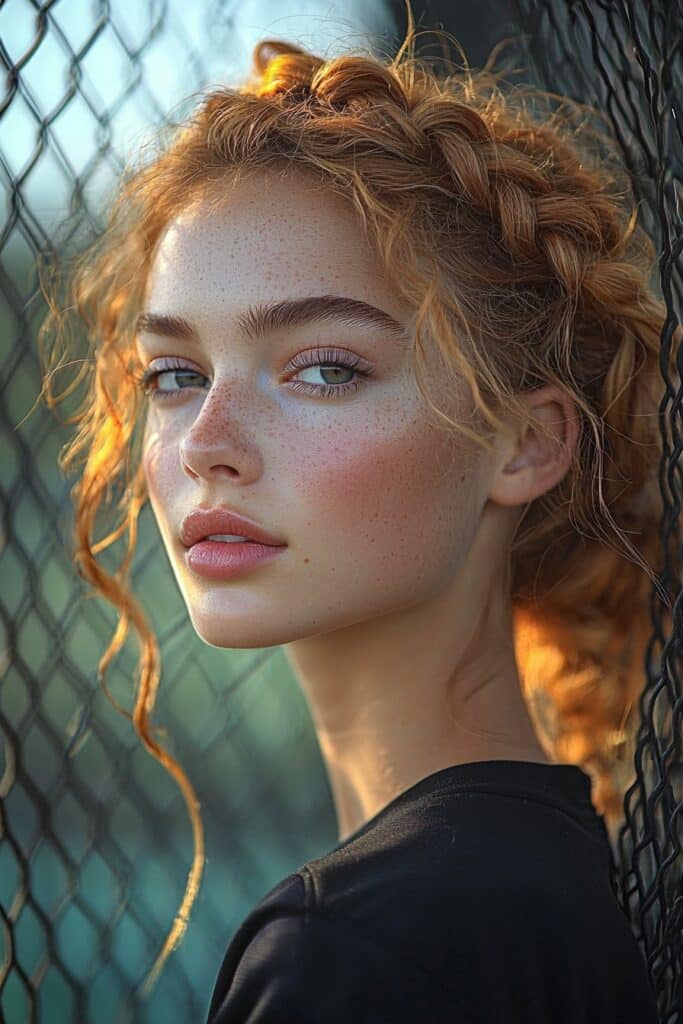
The twisted crown braid saves the day for softball players with 2A-2C curl patterns. This elegant yet practical style frames the face perfectly and keeps loose curls in place during those intense innings.
Prepping 2A-2C Curls
Loose curls need specific preparation to hold braids well. My technique starts with slightly damp hair—dry enough to work with, but moist enough to keep its shape. My 2A-2C clients get the best results with a lightweight mousse applied throughout their hair. This creates grip without weighing down their natural texture. A quick brush with a wide-tooth comb smooths any tangles while keeping the curl pattern intact.
Creating the Perfect Crown
This style’s beauty comes from its simplicity:
- Part your hair down the middle from forehead to nape
- Take a small section from your hairline on one side
- Divide into two equal pieces and begin twisting them over each other
- Twist and add hair from underneath into the bottom strand before crossing it over the top
- Keep adding hair and twisting around your head
- Switch which strands you’re holding to continue across the back once you reach your ear
- Complete the circle back to where you started
- Secure with bobby pins and tuck ends underneath
The best part? This hairstyle takes just five minutes but looks amazing!
Securing for High-Impact Movement
These tips make the style softball-ready:
- Insert bobby pins randomly throughout the braid
- Cross strands away from your face when creating the rope braid
- Pull sections gently for fullness without loosening
This style fits perfectly under helmets because it sits flat against the head without creating uncomfortable pressure points.
My Go-To Products for This Style
My loose-curled clients get great results with:
- A moisturizing leave-in conditioner applied before styling
- Twist Out Coconut Milk Crème for definition and shine
- A strong-hold hairspray that stays flexible
The style looks fantastic from game time through celebrations—just remove your helmet and you’re ready to celebrate your win!
Bubble Braids for Defined Curls
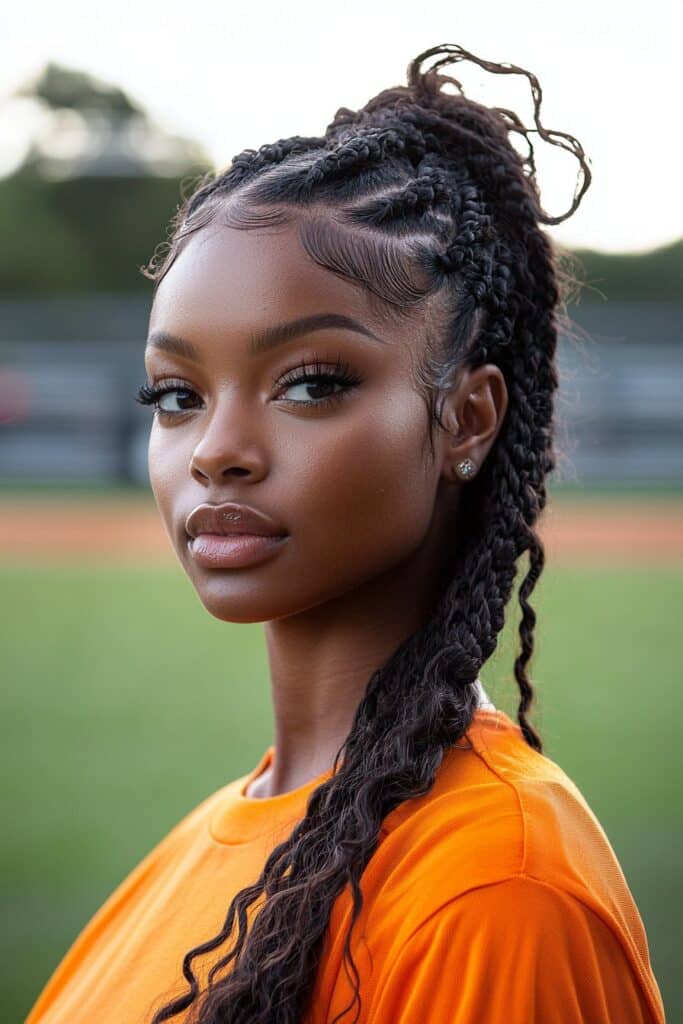
Bubble braids are a game-changer for my softball clients with defined curls. This fun and practical style gives you the perfect mix of security and style during those intense games.
Why Bubble Braids Work for Curly Hair
Bubble braids are a simple upgrade to your regular ponytail when you have curly hair. They work with your natural curl patterns instead of against them. Your head won’t hurt from the weight of a heavy ponytail because the sections spread the weight evenly.
Softball players love this style because it works with curls of all types. Whether you have loose waves or tight coils, the bubbled effect shows off your natural texture and keeps it in place. The bubbles create small pockets that let your curls keep their shape without getting big or frizzy during the game.
Step-by-Step Tutorial
You’ll be surprised how easy it is to create bubble braids on curly hair:
- Put curl-defining cream on damp hair
- Make a smooth ponytail at the height you want
- Use an elastic band close to your scalp
- Place another elastic 2-3 inches down
- Pull the hair between elastics gently to make your first “bubble”
- Keep adding elastics at equal distances
- Space the elastics 2-3 inches apart for the best bubbles with curly hair
- Spray some light-hold hairspray to control flyaways
Short hair? Try a half-up bubble braid with just the top section. It adds texture and keeps your look playful.
Styling with Team-Colored Accessories
The best part about bubble braids for softball? They’re perfect for showing team spirit! Here are some team-color ideas:
Match your uniform with colored elastic bands for each section. My clients keep collections of team-colored elastics ready for game days.
Tournament time calls for double bubble braids – one on each side. Small team-colored scrunchies or ribbons between bubbles look great and help keep everything secure under your helmet.
Softball Hairstyles Braids with Bantu Knots
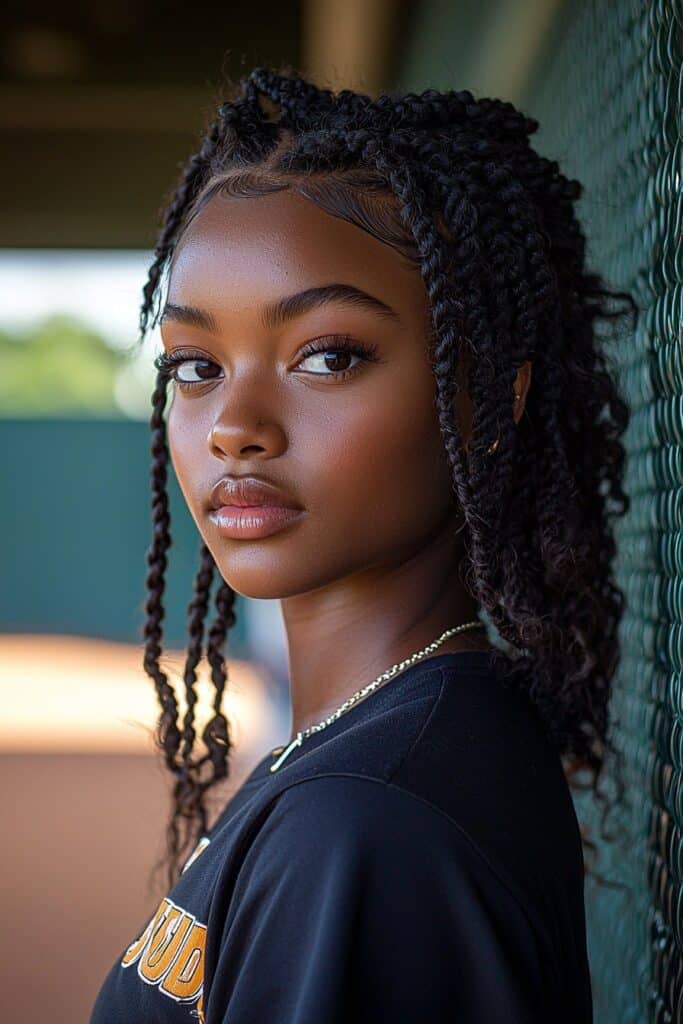
Bantu knots have transformed the game for my softball players with Type 4 curls. This age-old protective style celebrates cultural heritage and works amazingly well during intense gameplay.
Protective Styling for Type 4 Curls
Type 4 curls love Bantu knots because they need minimal daily handling and keep moisture locked in. I always start with clean, deep-conditioned hair. My daily work with athletes has shown that a well-moisturized base makes all the difference—your hair stays hydrated longer through multiple games when you start with proper moisture.
My clients with tighter curl patterns get the best results when I use a leave-in conditioner and follow up with a custard-like product like Miss Jessie’s Honey Curls. This combo gives lasting hold without drying out the hair.
Creating Secure Bantu Knots
Here’s how to make game-ready Bantu knots:
- Section dampened hair into squares (smaller sections create tighter, more secure knots)
- Two-strand twist each section first, then wind into a knot
- Wrap the twist around its base, tucking ends underneath
- Secure with a small bobby pin at the base
The sweet spot is getting the right tension—secure enough to stay put but gentle enough to avoid scalp strain during long tournaments.
Helmet-Friendly Modifications
Smart placement of Bantu knots makes helmets fit better. Small knots along the sides help helmets sit properly without creating pressure points. A buff or cycling cap under the helmet stops friction between knots and equipment—a tip I picked up from clients who wear protective styles with sports gear.
Post-Game Takedown Tips
The right takedown technique prevents damage after intense games. Start by removing bobby pins, then unwind each knot opposite to how you created it. When knots have been in through multiple games, a little oil at the base helps release tangles before unwrapping. A light moisturizing spray refreshes your curls afterward and gets them ready for the next style.
Curly Mohawk Braid for Medium Length Hair
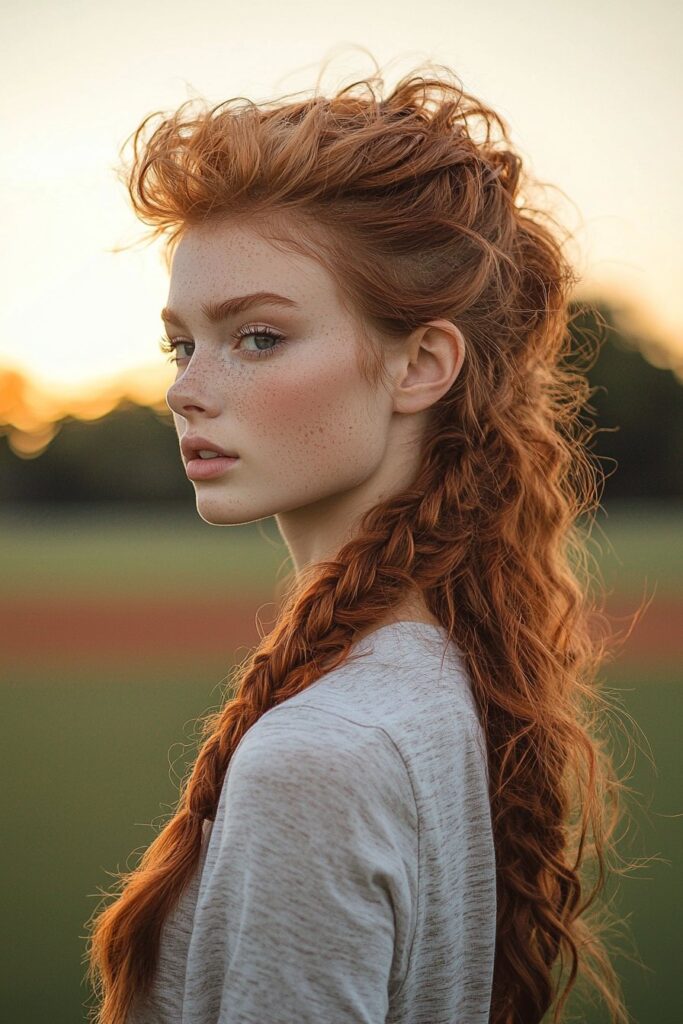
The mohawk braid has become one of my favorite styles for curly-haired athletes who want something secure yet stylish. My daily work with softball players has helped me perfect this technique. It works great for medium-length curls that need to stay in place through diving catches and home run celebrations.
Prepping Curly Hair for Braiding
The perfect mohawk braid starts with good preparation. Clean hair creates the best foundation. My clients with curly textures get a light spray of Redken Quick Tease from 6-8 inches away. This protects their hair from heat damage and gives it the right grip.
I tap a texturizing iron down the hair’s length to create manageable texture. This helps curly hair that might be too slippery to braid well. A styling brush smooths everything out while keeping the volume we need.
Here’s a pro tip I’ve learned: braiding slightly damp curly hair makes it easier to work with and the style stays put during the game.
Creating Height and Security
Let me walk you through this statement-making style:
- Section off the “mohawk” portion from temple to temple across the top of the head
- Secure the sides into a smooth, tight low ponytail with a hair bungee for maximum hold
- Take a small section from the ponytail and wrap it around the base to hide the bungee
- Begin your French braid at the hairline with three sections
- Cross the right strand under the center strand, then the left under center
- Add hair from the loose pieces on the same side before each cross-over
- Continue braiding down the length and secure with a clear elastic
The key is creating tension without discomfort – a balance I’ve mastered after years with my athletic clients.
Products for Long-Lasting Hold
Pattern Strong Hold Gel works best for curly-haired athletes. It holds well without breaking hair or flaking during intense movement. The gel’s slip makes it easy to work through curly textures.
AllDay Locks Braid Gel is my go-to for clients with dense curls. It keeps everything in place and controls frizz throughout the game. You can also use it as edge control for those baby hairs.
Light layers of hairspray work better than one heavy coat. Your hair stays flexible but secure – exactly what you need for peak performance.
Flat Twist Updo for Short Curly Hair
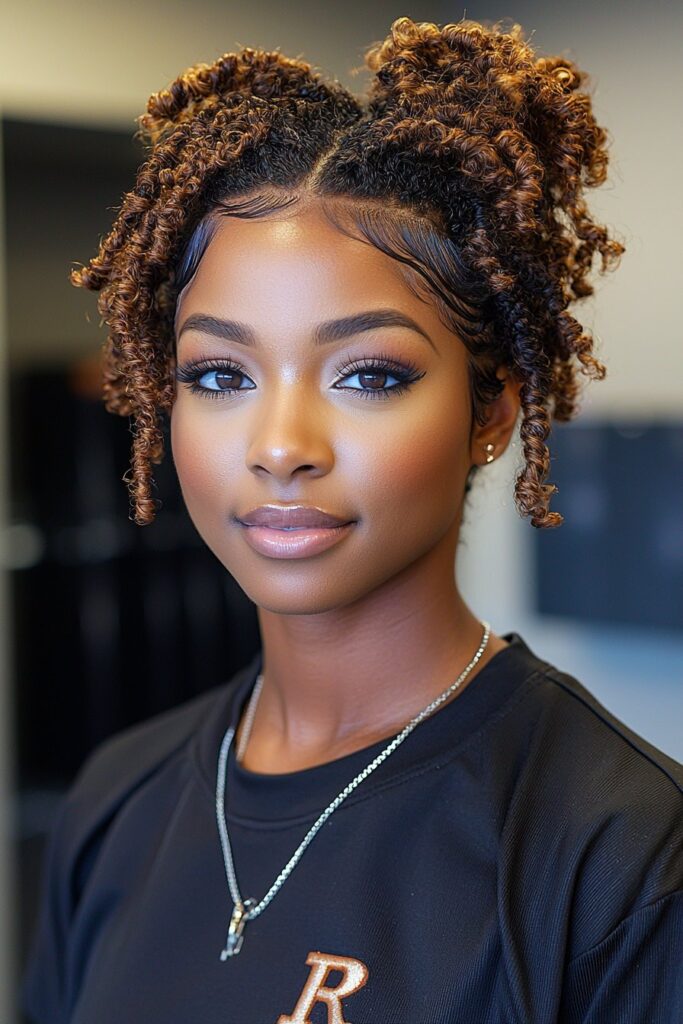
Flat twists have changed the way I style short curly hair for softball players. This protective style works great and adds flair while keeping shorter curls in place throughout the game.
Working with Short Curly Textures
Short curly hair can be tricky to style because you don’t have much length to work with. My clients with shorter curls get better results when I start with slightly damp hair. This gives better grip without causing frizz. A leave-in conditioner goes on first, followed by a strong-hold styling cream.
Short curls work really well with flat twists because the style is simple. Even the shortest curls twist well with the right technique. The process starts with a good detangle using a wide-tooth comb. Then the hair needs to be split into sections based on your design.
Creating Secure Flat Twists
Softball players need their hair to stay put. Here’s my proven method:
- Create clean, even parts using the edge of a rat-tail comb
- Apply edge control or styling gel along each part for grip
- Start with two even sections at the beginning of your part
- Cross one section behind the other (unlike cornrows where you cross over)
- Use your pointer finger to slide into loose hair and gather a small section
- Add this new hair to the section you just twisted
- Continue this pattern until you reach the end of your part
Flat twists differ from traditional braids because they use two strands instead of three. This makes them easier on sensitive scalps and fine hair.
Styling Options for Different Positions
Each position needs its own twist style. Outfielders look great with 5-7 twists that join into a low bun at the nape. Catchers need their style to fit under equipment, so I create flat twists that form a halo around the head.
Pitchers need their hair away from their face without bulk at the back. This style works perfectly for everyone on the field because it’s so versatile.
Braided Space Buns for 3A-3C Curls
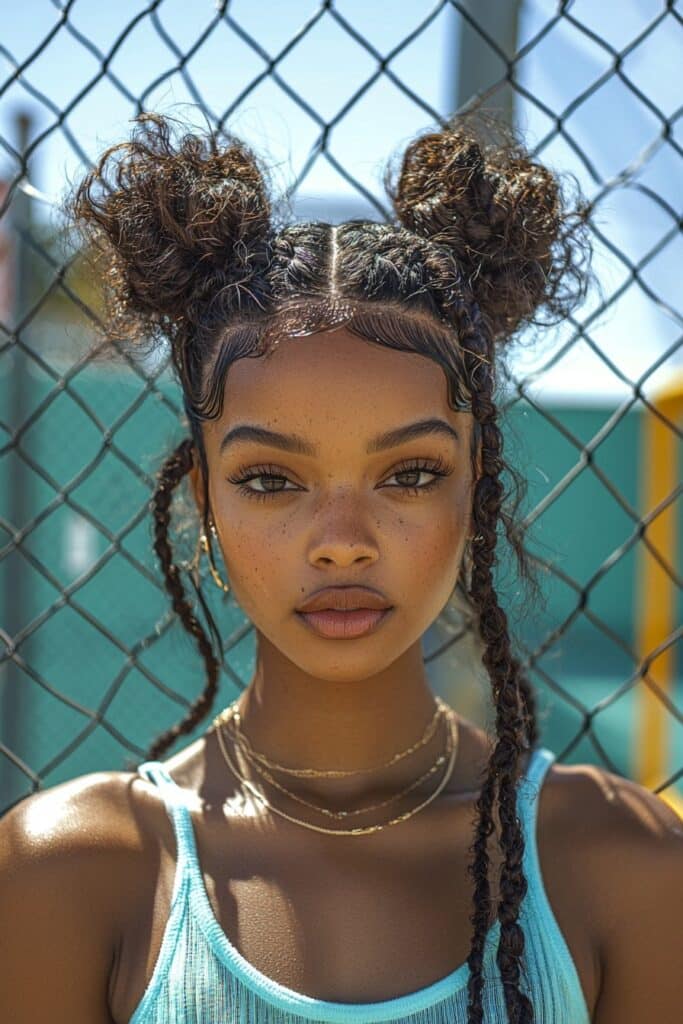
Space buns with braids give my softball clients who have 3A-3C curls a perfect mix of security and style. My work with athletes over the last several years has shown this style really shines. It keeps bouncy curls in check while enhancing their natural texture.
Pre-Game Prep for Defined Curls
The right preparation makes a big difference for 3A-3C curl patterns. Slightly dirty hair works best – third or fourth-day curls have better grip and texture. A lightweight mousse throughout the hair helps with hold when you’re starting with freshly washed hair.
Start by gently detangling with a wide-tooth comb from the ends up. A light water spray refreshes curl definition. Then apply curl-defining gel to midshafts and ends. This keeps the curl pattern intact and fights frizz during intense play.
Creating Secure Space Buns
Here’s my method to create braided space buns that stay put:
- Part hair evenly down the middle from forehead to nape
- Create two high pigtails on either side of the head
- Braid each pigtail—traditional three-strand braids work great for 3A-3C textures
- Secure each braid with a clear elastic
- Gently tug on the outer loops of each braid for volume
- Wrap each braid around its base to form a bun
- Secure with bobby pins, tucking ends underneath
- Finish with a light mist of strong-hold hairspray
Braiding really sets this style apart from regular space buns and gives extra security for curly textures.
Helmet Compatibility Tricks
Place your buns slightly forward instead of right on top to get the best helmet fit. This leaves room for the back of the helmet while keeping hair in place. A silk handkerchief tied over the head before putting on helmets helps too. It creates a barrier that stops frizz and breakage.
Lower space buns just above the ears are another great option. This placement fits well with most softball helmets and still looks cute.
My Client Success Story
A center fielder with 3B curls came to me last season because her hair kept escaping her ponytail. We tried many styles before finding that braided space buns were perfect. The change was amazing—her hair stayed in place through doubleheaders, and she felt more confident without fixing her hair constantly.
This style proved incredibly versatile. She could go straight from the game to celebrations by taking off her helmet. Her hair looked great through diving catches, humidity, and even unexpected rain. Now she won’t wear anything else!
Curly Ponytail with Reinforced Base
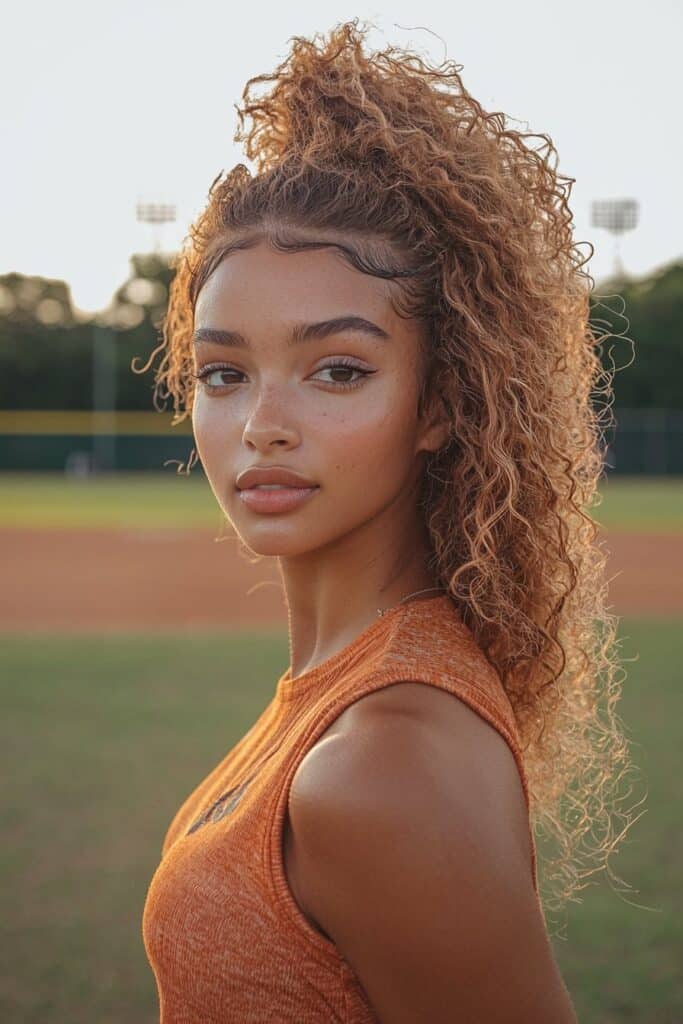
A simple ponytail becomes much more effective when you build a strong base. My years of styling athletes’ curly hair have taught me that a solid foundation makes the difference between a ponytail that collapses early and one that stays put through the entire game.
The Foundation for a Secure Ponytail
Building a rock-solid ponytail starts with the right preparation. The best results come from tilting my clients’ heads upside down to maximize volume and tension. This lets me gather all the hair without pulling too hard on the roots. Here’s what works best for athletes with curly hair:
- Smooth the back of your head with a fine-tooth comb and a light water mist
- Apply your got-to-be spray to shape the back of your head upward
- Stretch the hair upward to create the right tension
- Make sure you don’t leave that annoying “crinkle” at the nape from loose tension
Your ponytail should sit right at the crown – not too high or low – this works best with helmets.
Anti-Frizz Products That Actually Work
Modern anti-frizz formulas stand up well against humidity. Master hairstylist Adriana Papaleo says, “Anything from environmental factors to the texture of the hair itself, and styling techniques can contribute to the frizz factor.”
These products give great results for my softball players:
- Light custards that define curls without weight
- Balms containing seed oils that block humidity
- Products featuring “Ocean Silk Technology” that add silk proteins
- Leave-in conditioners that work as light styling aids
Styling for Maximum Hold
The base needs extra reinforcement to last through intense games. Start with your basic ponytail, then wrap some hair around the elastic to hide it and secure it with bobby pins. A small claw clip just under the hair tie adds structure without bulk.
Use products sparingly. Too much product builds up and weakens your style. A thin layer of edge control combined with targeted blow-drying creates a sleek look that lasts.
Softball Hairstyles for Short Curly Hair: Twist Out Pixie
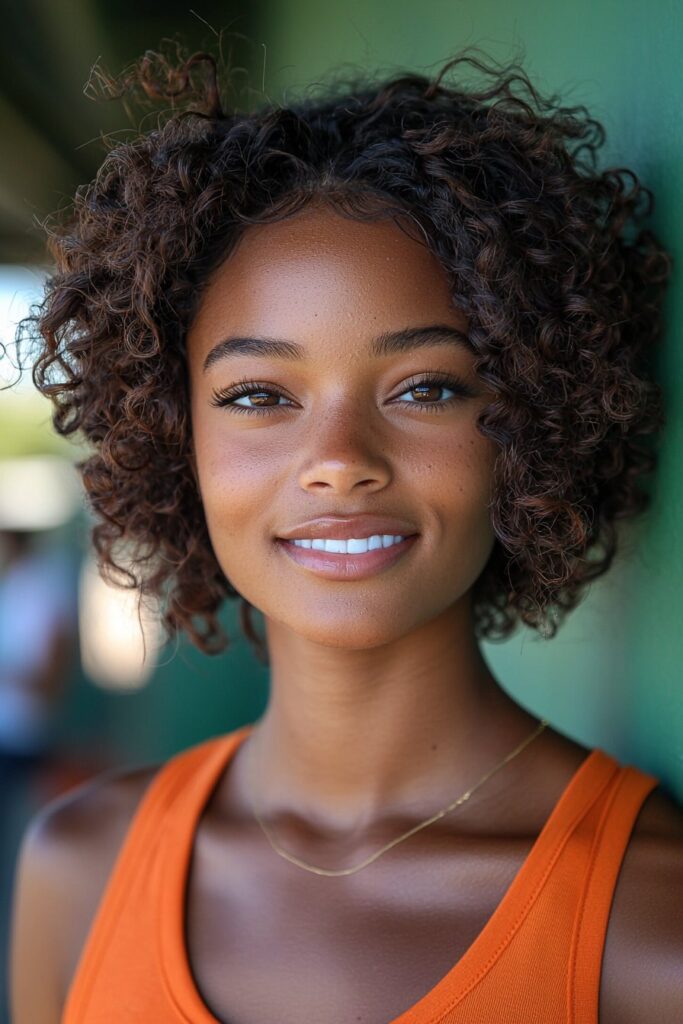
Short curly pixie cuts don’t get enough credit in softball, but I’ve discovered the twist out technique changes these styles into perfect game-day looks. My clients with cropped curls often sit in my chair feeling stuck with limited styling options. The versatile approach I suggest works great under helmets and shows off their natural texture.
Prepping Short Curls
Your pixie twist outs need proper preparation. Start by cleansing with a sulfate-free shampoo to get rid of product buildup. We focused on the roots because that’s where oil and grime build up. Next, apply a hydrating conditioner and use a wide-tooth comb to detangle from ends to roots.
The LOC method (Leave-in, Oil, Cream) works best on clean hair:
- Apply a lightweight leave-in conditioner
- Seal with a small amount of natural oil
- Finish with a curl-defining cream
Pixie cuts need less product than longer styles. Too much product makes shorter curls look flat instead of giving them volume and definition.
Creating Definition and Hold
Here’s the quickest way to create well-defined twists in short hair:
- Section damp (not soaking wet) hair into small, manageable parts
- Take a small section and divide it into two strands
- Twist these strands around each other from root to tip
- Coil the twist around your finger for extra security
- Repeat this process on your entire head
Pixie cuts need smaller twists – pencil-width mini-twists work best. Very short sections that won’t twist should be coiled around your finger to set the curl pattern.
Let the twists dry completely to get good definition. The best results come from twisting your hair the night before game day.
Game Day Styling Tips
The next day, unravel each twist by gently twisting the opposite way. Start from the ends and work up to the roots. Don’t separate each twist too much – pixie cuts look better with definition rather than volume.
A light mist of holding spray makes this style softball-ready. A comfortable headband keeps shorter pieces in place and adds team spirit with matching colors.
This style works great with helmets because it stays close to your head without bulk. A silk scarf or cycling cap under your helmet stops friction from ruining your definition during the game.
Banded Ponytail for Thick Curly Hair
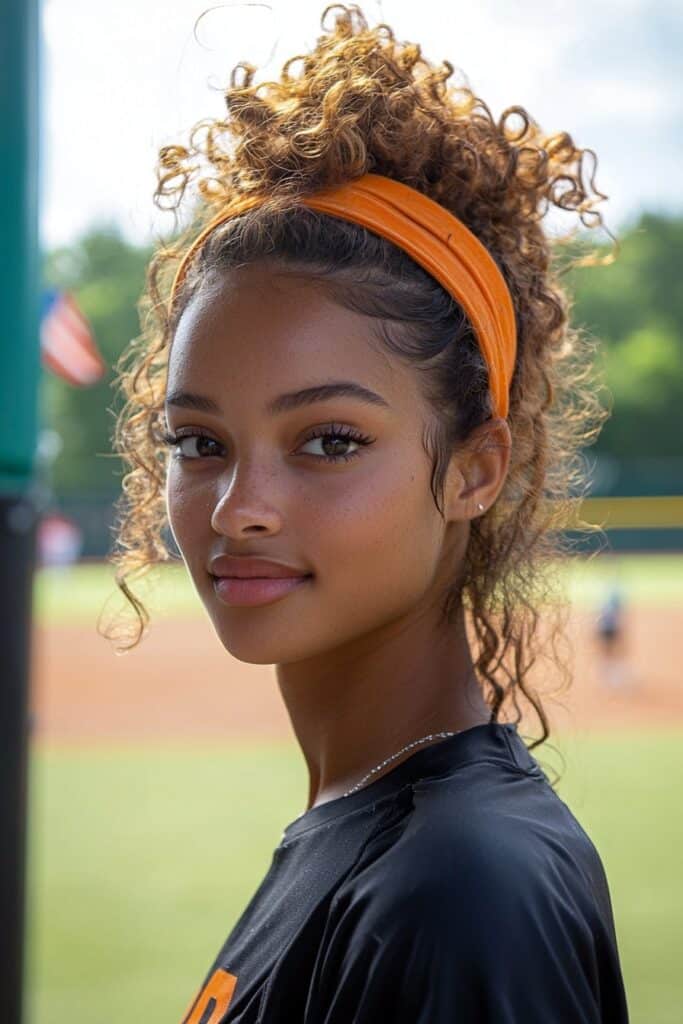
The banded ponytail works like magic for athletes with thick, voluminous curls. My experience styling hair for players who deal with thickness and humidity has taught me the perfect technique. This method helps manage weight and keeps everything secure through nine innings.
Managing Volume and Weight
Thick curly hair creates unique challenges. The extra weight often leads to headaches during long games. You need properly moisturized hair before any styling begins. I use a lightweight leave-in conditioner on damp strands and avoid heavy products that could weigh down the curls more.
Your best bet is to section thick hair before styling. This technique spreads the weight evenly and stops that uncomfortable pulling at your scalp. While detangling, work from the ends up with a wide-tooth comb to protect your hair from breaking.
Creating a Secure Banded Style
Here’s how to create a banded ponytail that stays in place:
- Start with slightly damp hair (not soaking wet)
- Brush the hair upward into a high ponytail
- Secure with a strong elastic at your desired height
- Place additional hair ties every 2-3 inches down your ponytail’s length
- Pull the hair gently between elastics to create “bubbles”
- Keep going until you reach your ponytail’s end
The secret lies in keeping consistent tension between bands. You want it secure enough to handle diving catches but not so tight that it damages your hair.
Products for Humidity Control
Athletes with curly hair must use humidity-resistant products. Wonder Ponytail Bond Freeze Spray has become my favorite because it resists oil and perspiration. Your style will stay intact whatever the conditions – oily skin, sweat, or high humidity.
Look for “extreme hold” edge control products that block moisture without flaking during play.
Position-Specific Modifications
Your position affects how you should wear this style. Outfielders need a higher ponytail placement to keep hair off their neck during long runs. A catcher’s ponytail sits lower to work with their equipment without creating pressure points.
Players who wear helmets need strategic band placement. This prevents uncomfortable pressure spots when they put on their gear.
Easy Softball Hairstyles for Curly Hair: Modified French Braid
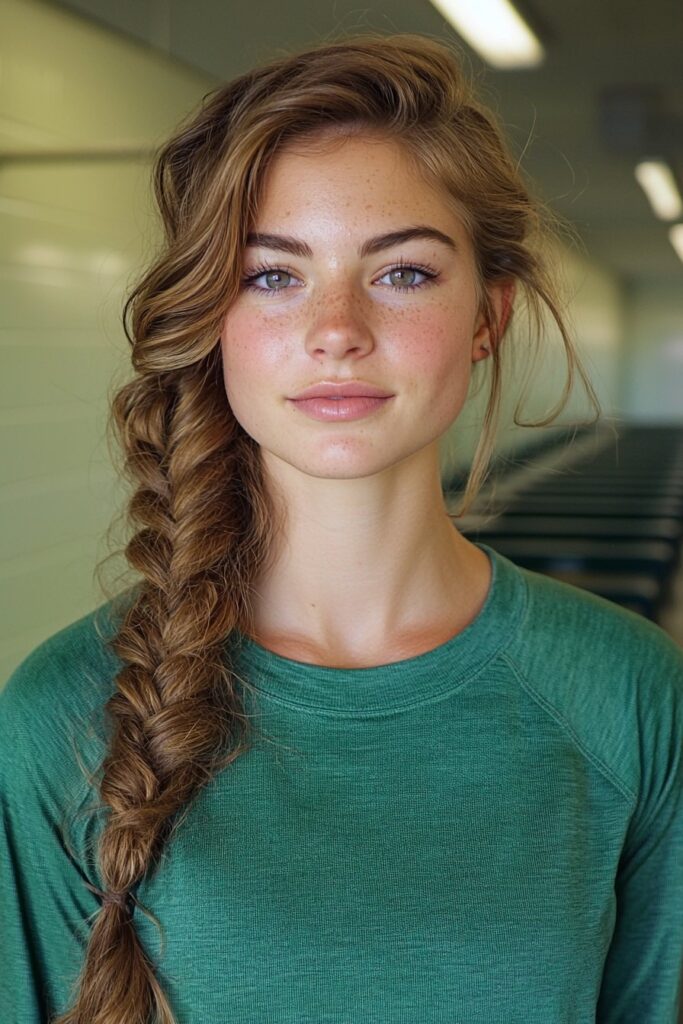
French braids remain a timeless hairstyle choice for athletes, though they’ve always been challenging at the time for people with curly hair. My experience styling softball players over the last several years has taught me a modified technique that works with curly textures instead of fighting them.
Adapting French Braids for Curly Texture
Standard French braids can frustrate curly-haired athletes because beautiful curls tend to slip out or create unwanted frizz. My key modification involves working with slightly damp hair rather than completely dry strands. The best approach after washing is to use a leave-in conditioner made specifically for curly hair. This helps you add moisture and minimize frizz.
A technique I’ve mastered uses fingers instead of a brush with curly textures. This keeps the natural curl pattern intact and prevents the frizz that brushing typically causes. My experience with tighter curl patterns shows that keeping whole curls together, rather than separating them, creates a more secure braid with minimal frizz.
Step-by-Step Tutorial
- Start with slightly damp, detangled hair (use a wide-tooth comb or fingers instead of brushing)
- Apply a curl-defining cream to add grip and minimize frizz
- Part your hair down the middle to create even sections
- Begin at the crown with three small sections
- Cross the right section over the middle (unlike Dutch braids that go under)
- Cross the left section over the new middle section
- Add hair from that side before each cross-over to incorporate it into the braid
- Keep this pattern going until you reach your neck’s nape
Securing Ends for Active Play
A game-ready French braid’s success depends on its finish. Secure the ends with a small elastic matching your hair color. Players can achieve maximum security during intense games by wrapping the end with a small section of hair. This conceals the elastic and provides extra hold.
French braids stay flat against the head, unlike bouncing ponytails. This makes them perfect for helmet wear. Softball pitchers benefit from slightly looser braids that prevent headaches, while catchers need tighter, more secure styles.
Halo Braid for Long Curly Hair
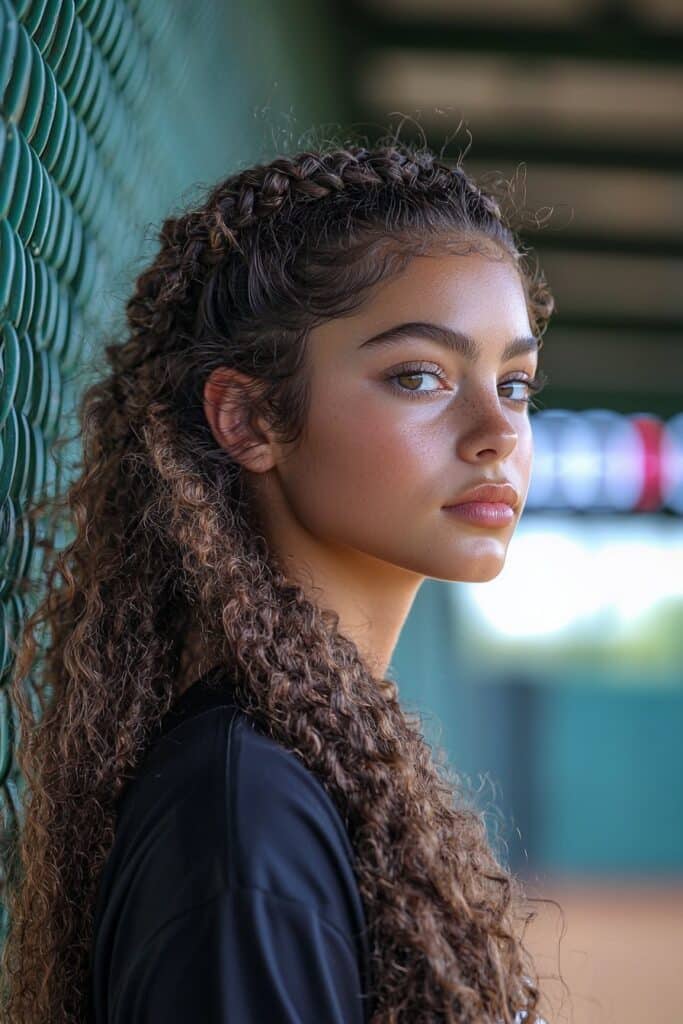
Halo braids are the perfect solution for softball players who have long curly hair. This elegant style stays put during intense games and players don’t need to worry about their hair getting in the way.
Prepping Long Curls for Braiding
Your long curly hair needs proper prep work before a halo braid. I start by applying leave-in conditioner to slightly damp hair. A crimping iron helps create grip and texture on small sections before braiding. This technique makes your hair look twice as full and adds character with mini-crimps throughout. A few sprays of texturizing product work great when your curls are too slippery.
Creating a Secure Halo
Here’s how you can create a game-ready halo braid:
- Create a deep side part above one eyebrow
- Begin Dutch braiding (crossing strands under rather than over)
- Pick up hair only from underneath as you go
- Continue braiding around your head until you reach your starting point
- Secure the ends by tucking them under and pinning in place
- Gently pull at each section’s edges to create fullness
The trickiest part? Getting around that corner near your ear! You’ll need to switch which hand holds each section when moving around the back of your head. I use a clip just above my working area to keep everything steady during this switch.
Helmet-Friendly Adjustments
Softball players need their hairstyles to work with helmets. I place the braid a bit lower than usual to avoid pressure points while keeping it secure. A silk scarf between your hair and helmet helps reduce friction and keeps frizz away.
My Personal Experience with This Style
My own curly hair has gone through countless games with this style. The halo braid looks amazing from first pitch to post-game celebrations. One of my clients, a college softball pitcher with beautiful 3C curls, wore this style through a whole tournament weekend without fixes – proof of how well it holds up!
Cute Softball Hairstyles for Curly Hair: Half-Up Dragon Braid
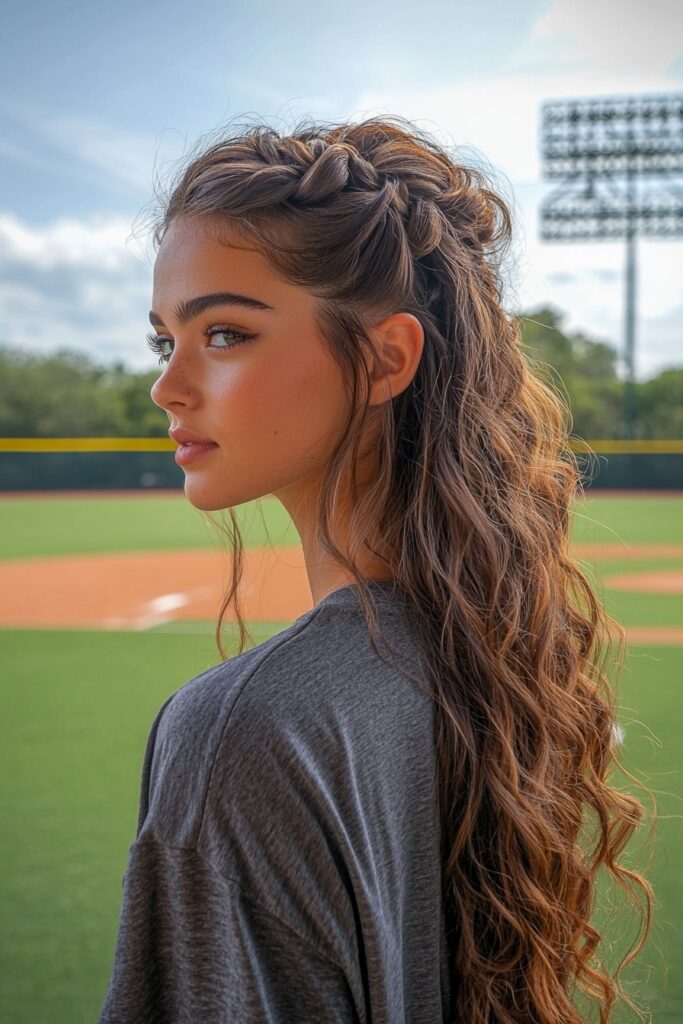
The half-up dragon braid has become my go-to style recommendation for curly-haired athletes who want that perfect mix of function and style. My experience as a hairstylist working with a variety of curl patterns has helped me find this technique that offers amazing staying power and looks stunning too.
Defining Your Curls Before Styling
Your prep work makes all the difference with dragon braids. My best results come from working with day 2 or 3 curls instead of freshly washed hair—this cuts down styling time and gives better grip. A lightweight curl-defining cream works great to refresh natural curls without making them heavy. Your slightly dirty hair will actually help create better texture and hold.
Creating the Dragon Braid Effect
The dragon braid creates a beautiful dimensional effect without traditional braiding techniques. Here’s how to create this look:
- Part hair down the middle using a pintail comb
- Section the top half of your hair from the crown to behind the ears
- Create a high ponytail with this section
- Divide the ponytail into two equal sections (top and bottom)
- Split the top section in half, creating a gap
- Pull the bottom section through this gap and clip it away temporarily
- Secure the hanging sections with an elastic
- Continue this pattern, gently pulling at the sides to create volume
This technique creates bumps that look like scales down a dragon’s spine, making it secure and eye-catching during active play.
Securing Loose Curls
The “half-down” portion needs attention just like the dragon braid. A small amount of bonding oil on loose curls adds shine and controls frizz. These products will help maintain definition during gameplay:
- Lightweight custards that define without heaviness
- Hairspray with flexible hold to keep curl pattern
- Edge control for those baby hairs around your face
Transitioning to Post-Game Events
This style’s versatility shines after the final inning. You can head straight from the field to celebrations without restyling. Just take off your helmet, give your loose curls a quick refresh with water mist, and you’re ready for anything!
Conclusion
These 15 hairstyles have proven to be reliable solutions for every curl pattern and position on the field. My years of styling curly hair for softball players have taught me something crucial – secure, comfortable styles help players focus on the game instead of adjusting their hair constantly.
I’ve watched these styles shine through countless games and tournaments. Dutch braids stay perfect during diving catches, and protective box braids last entire seasons. Each style brings its own advantages. Players with tight coils get the moisture protection they need, while those with loose waves achieve the definition they want.
The success of any curly hairstyle depends on proper preparation. Well-moisturized hair, the right products for your curl pattern, and time spent securing your style will give you worry-free gameplay.
These styles work because they complement your natural texture rather than work against it. My softball clients tell me how these hairstyles have revolutionized their game experience. They can now focus completely on their performance without worrying about their hair.
Test these styles during practice to find what suits your curl pattern and position best. Simple adjustments can make a huge difference in comfort and security, especially with helmets and other equipment.
